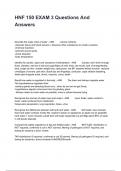HNF 150 EXAM 3 Questions And
Answers
Describe the major roles of water - ANS -carries nutrients
-cleanses tissue and blood-solvent-> dissolves other substances to create a solution
-chemical reactions
-lubricant around joints
-shock absorber
-body temperature
Identify the causes, signs and symptoms of dehydration - ANS Causes: don't drink enough
fluids, diuretics, eat lots of salt and sugarSigns of mild: thirst, dry mouth, lack of energy/feeling
tired, rough dry skin, sudden weight loss, rapid pulse, low BP, impaired kidney function, reduced
urineSigns of severe: pale skin, bluish lips and fingertips, confusion, rapid shallow breathing,
weak rapid irregular pulse, shock, seizures, coma, death
Recall how water is regulated in the body - ANS The brain and kidneys regulate water
The hypothalamus regulates thirst
-salivary glands are detecting blood conc., when its too low we get thirsty
-hypothalmus signals a hormone from the pituitary gland
- kidneys retain as much water as possible, urine is yellow because trying
Recognize the sources of water input and output - ANS Input- fluids, water content in
foods, water produced from metabolism
Output-skin perspiration, lung respiration, feces, urine
Recognize the differences between soft and hard water - ANS Soft water- less minerals
than hard water-contains mostly NA, maybe K-easier on appliances an pipes-not as palatable
hard water-> more minerals overall than soft water (especially Ca and Mg)-about 85% of water
in US-leaves deposits
Compare the safety regulations of tap and bottled water - ANS BOTTLED- disinfection is
NOT required, confirmed e coli is NOT banned, filtering of pathogens is NOT required, and
testing for bacteria is done 1/week
TAP-disinfection IS required, confirmed e coli IS banned, filtering of pathogens IS required, and
testing for bacteria is done hundreds HUNDREDS/month
,Solvent - ANS A liquid substance capable of dissolving other substances
water balance - ANS the balance between water intake and water excretion, which keeps
the body's water content constant
Dehydration - ANS A serious reduction in the body's water content
Diuretics - ANS Drugs that elevate the rate of bodily urine excretion
Electrolytes (ions) - ANS electrically charged ions in solution, (sodium, chloride, potassium,
magnesium, calcium), maintain balance of water outside the cell
Ions - ANS positively and negatively charged atoms
Hyponatremia - ANS deficient sodium in the blood
Recognize the roles of minerals in maintaining fluid, electrolyte, and acid-base balance. - ANS
Minerals form salts that dissolve in the body and direct where water goesterm-48 because water
follows salt. They separate into electrically charged particles called electrolytes. To control the
flow of water, the body moves these electrolytes from one body compartment to another to keep
a proper balance
State components of food that increase and decrease bioavailablity and absorption, and
generalcharacteristics of transport of minerals - ANS Bioavailability: "degree to which the
amount of an ingested nutrient is absorbed and is available in the body"- Food components
affect digestion and absorption- Mineral absorption is increased when need is increased:
deficiency, pregnancy, etc.
Increase:- Gastric acidity- Vitamin C (iron absorption), Vitamin D (Ca, P, Mg absorption)
Decrease:- Physic acids = whole grain fibers, breads, legumes-
Oxalic acid = leafy green plants-
Polyphenols = tea, chocolate, wine-
High dose of supplements of single minerals
1. Identify the main functions of each mineral in the body, deficiency diseases and/or symptoms
for eachmineral, best ways to obtain each mineral from food/main food sources: a. Iodine - ANS
Functions:1. Aids in regulating the BMR2. Needed for synthesis of thyroid hormones: thyroxine
and triodothyronine3. Thyroid hormones: Regulate BMR, Macronutrient metabolism, Brain &
Nervous System Development, and Growth
Deficiency: Goiter, Cretinism
Symptoms:1. Goiter - slowed metabolism, feeling cold, depression2.
, Cretinism - sevre intellectual dsability, loss of hearing and speech, very short statureFood
Sources: iodized salt (processed foods), saltwater seafood, seaweed, foods grown in iodine-rich
soil, and dairy
Identify the main functions of each mineral in the body, deficiency diseases and/or symptoms for
eachmineral, best ways to obtain each mineral from food/main food sources: Zinc - ANS 4
MAIN: DNA synthesis, Helps reactions, Antioxidant, digestion
2. Overt: Affects behavior and learning, Assists in immune function, Essential to wound healing,
Sperm Production, Taste Perception & Fetal Development3.
Deficiency/Symptoms: loss of appetite and sense of taste, delayed growth (stunting) and sexual
maturation, immune dysfunction: dermatitis & diarrhea, birth defects & infant mortality
Food Sources: mollusks, red meat, seafood, nuts, legumes, whole grain (not fortified in refined
grains), dairy (plant-based sources not well abosrbed)
Identify the main functions of each mineral in the body, deficiency diseases and/or symptoms for
each mineral, best ways to obtain each mineral from food/main food sources: Flouride - ANS
Functions: promotes re-mineralization of tooth enamel
Deficiency/symptoms: nausea, diarrhea, seizures, coma
Food Sources: fluoridated water, tea, seafood, and seaweed
Identify the main functions of each mineral in the body, deficiency diseases and/or symptoms for
eachmineral, best ways to obtain each mineral from food/main food sources: Calcium - ANS
Functions: - stored in bones & teeth
1. Bone remodeling (ongoing process of rebuilding & repair) - bones, teeth, and living tissue
2. Nerve transmission
Deficiency: Rickets, Osteoporosis (Osteopenia, Kyphosis)
Symptoms: low peak bone mass, bone loss, bone pain, soft bones, bowed legs, short
stature/growth retardation, enlargement of ends of long bones, deformities of ribs, poorly formed
teeth, weakened muscles, increased Ca in stools & compressed vertebrae and fractures
Food Sources: dairy, leafy greens, fortified juices, non-dairy milk and cereals, calcium-set tofu
(high oxalate = spinach, swiss chard, rhubarb)-50% of Ca comes from dairy products
Identify the main functions of each mineral in the body, deficiency diseases and/or symptoms for
each mineral, best ways to obtain each mineral from food/main food sources: Magnesium - ANS
Functions:1. Assists in enzyme function
2. Energy metabolism
3. Affect metabolism of potassium, calcium & vit D




